Description
The first Warsaw baroque church with a simple facade, it has a nave, a rectangular interior and two side chapels. The porch has a separated lattice (from the 18th century), and the side altars have images of St. Francis and St. Anthony of Padua, painted by Rafał Hadziewicz, and an image of Christ on the Cross painted by Annibale Vinici.
Inside the galleries are numerous epitaphs for deserving people (including the writer Klementyna Hoffmanowa, the painter Rafał Hadziewicz, the poet Stanisław Jachowicz, the president of Vilnius Wiktor Malaszewski, and Stanisław Englert), people killed during World War II, people who died in Nazi concentration camps, and Polish soldiers who fought in defence of their country.
History
Construction of the first church at this site was funded by King Sigismund III Vasa, thankful for winning the Siege of Smolensk, in 1611. The date of the event (13 June) suggested St. Anthony of Padua as the choice of the patron saint for the church. A resolution in the Sejm entrusted the church to the Order of the Franciscans reformers.
During the Swedish invasion in 1657, the original wooden church was destroyed by allied troops led by George II Rákóczi.
Castellan Stanisław Skarszewski founded the new church between 1668 and 1680, this time built of brick. In 1679 the temple was consecrated by the Bishop of Poznań Stefan Wierzbowski. The church was probably built to a design by Simone Giuseppe Belotti. Sculptures inside the church are the work of Jan Jerzy Plersch.
The temple was often visited by King John III Sobieski. From 1734 to 1735 King Augustus III of Saxony had a box built for him and his wife (the royal couple lived in a palace next door) on the right side of the chancel. In 1766, the monastery hid the famous Casanova, who was wanted by Franciszek Ksawery Branicki.
From 1767 to 1781 the chapel of the Virgin Mary was built, and in 1792 the cloister was built perpendicular to the side arms to a design by Hilary Szpilowski. In 1850, a painting of the Virgin Mary, was added beside the tympanum at the front, and in 1851 a figure of Mary by Antoni Messing was placed on the pediment in the church.
In 1866 the parish was founded. In 1867, in connection with the dissolution of the Order of the Franciscans in the repression following the January Uprising, the church was taken over Diocesan priests. In subsequent years, the main altar was moved to the wall of the chancel, and choir and sacristy were removed.
In 1895 the chapel of the Holy Family was built with an altar made by Wincent Bogaczyk. In 1907 the chapel was built for the Sacred Heart of Jesus.
The church was badly damaged by the German army during the battles with insurgents in 1944. Especially affected were the side altar, the pulpit and organ, the chapel of Holy Family, the grille, and a part of the chapel's stucco arches. There was considerable human cost too - as mentioned on a Tchorek plaque at the church, over 100 people were executed there.
The church was rebuilt from 1950 to 1956 according to a design by Karol Szymański. The main altar was consecrated by Cardinal Stefan Wyszyński on 18 January, 1969.
In 1949 the church and parish had again been transferred back to the Franciscan Order.
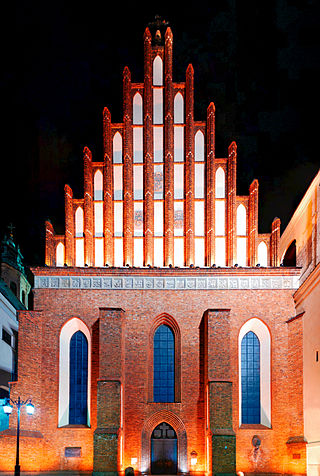
St John's Archcathedral is a Catholic church within the Old Town precinct in Warsaw, Poland. The Brick Gothic structure stands on Świętojańska Street, adjacent to the Jesuit Church. St John's is one of three major cathedrals in the city, but it is the only temple that also possesses the title of an archcathedral. It is the mother church of the Archdiocese of Warsaw and one of Poland's national pantheons. Along with the old city, the church has been listed by UNESCO as a World Heritage Site.

The Archcathedral Basilica of the Assumption of the Blessed Virgin Mary, usually called simply the Latin Cathedral is a 14th-century Roman Catholic cathedral in Lviv, western Ukraine. It is located in the city's Old Town, in the south western corner of the market square, called Cathedral Square.
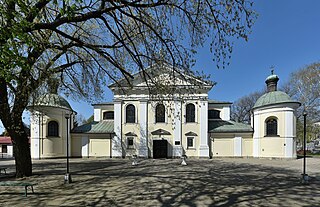
The Church of Our Lady of Loreto is an ornate church in Praga, a district of Warsaw, Poland, on the east bank of the Vistula River. The church stands on Ratuszowa Street and is Praga’s oldest monument. What may be seen today is a former chapel that on its south side was once attached to a baroque church and a Bernardine monastery.

The Church of St Paul the Apostle, Wightman Road, Harringay, London, N4, serves the parish of Harringay in north London. In ecclesiastical terms the parish is part of the Edmonton Episcopal Area of the Diocese of London. In political terms the parish is in the London Borough of Haringey.
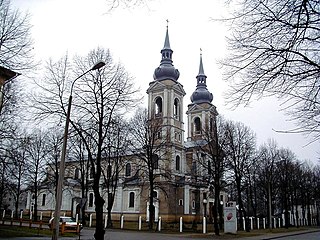
St. Albert's Church is a Roman Catholic church in Riga, the capital of Latvia. The church is situated at the address 38 Liepāja Street. It is the biggest catholic church in Latvia it can host around 2500 people.

The Church of Saint John of Jerusalem outside the walls is a Roman Catholic parish church in the city of Poznań in western Poland. The original church on this site was built at the end of the 11th century, making it one of the oldest churches within the present boundaries of Poznań.

The church in Niepokalanów, devoted to the Blessed Virgin Mary the Immaculate, the Omni-mediatress of All Glories, was designed by the architect from Cracow – Zygmunt Gawlik. It was built between 1948 and 1954, in difficult times for Poland. In June 1950 it became a parish church for a new parish in Niepokalanów.

St. Anthony of Padua Church in Łódź-Łagiewniki - Baroque Franciscan parish church, built in the first half of the 18th century, located in Łódź-Łagiewniki. Since 1946 it belongs - along with the monastery - to the historic buildings of Łódź.

The Metropolitan Cathedral of the Holy and Equal-to-the-Apostles Mary Magdalene is a Polish Orthodox cathedral, located at al. Solidarności 52 in Warsaw.

The Church of St. Anthony of Padua is the parish church of the Parish of St. Boniface in Czerniaków in Warsaw.

The Church of the Poor Clares dedicated to Assumption of the Blessed Virgin Mary is an historical church in Gdańska Street, Bydgoszcz, Poland.
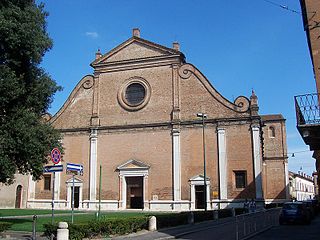
San Francesco is a late-Renaissance, Roman Catholic minor basilica church located on via Terranuova in Ferrara, Emilia-Romagna, Italy.

The Church of St. Francis is a church adjoining Franciscan convent in Warsaw's New Town.

The Church of the Assumption of the Blessed Virgin and St Anthony of Padua is a parish church in Milejów, Lublin Voivodeship, Poland.
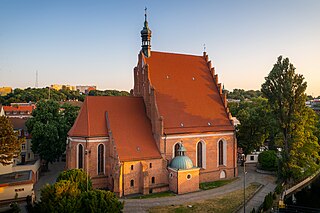
St. Martin and St. Nicholas Cathedral, or simply known as Bydgoszcz Cathedral, is a Catholic church built in the 15th century. It has a Gothic style, serves as a parish church and cathedral of the Diocese of Bydgoszcz. It also houses a shrine dedicated to the Virgin Mary. Its address is 10 Farna Street.
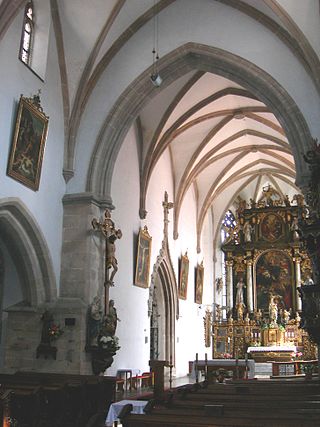
The Franciscan Monastery is located near the Main Square in Plzeň, Czech Republic. Originally belonging to the Minorites, the later Franciscan monastery was founded at the end of the 13th century. The Church of the Assumption of the Virgin Mary, Chapterhouse and Chapel of St. Barbara also belong to the monastery complex.

The St. Catherine of Alexandria Church is a Roman Catholic church in the Tabán quarter of Budapest, Hungary. It is the parish church of the Tabán Parish which also comprises parts of Gellért Hill and Naphegy. The church is a listed monument that was built in Central European Baroque style between 1728 and 1777. It was reconstructed several times in the 19th–20th centuries.

The Bernardine Church of Our Lady Queen of Peace is a historic church from 1557, located in Bernardyńska street, in Bydgoszcz, Poland. Its patron was initially Saint George: in 1971, Polish primate Stefan Wyszyński changed its title to the current one.

The Church of the Holy Polish Brothers Martyrs is a catholic temple which has been elevated to the rank of a sanctuary. It houses the relics of the "Five Saint Polish Brothers". In 1984, Father Popiełuszko celebrated there his last Holy Mass before being abducted and assassinated by members of the Security Service.
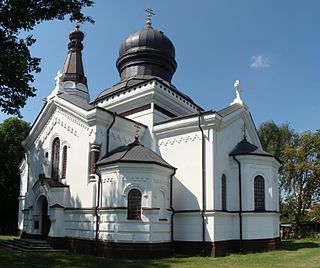
The Church of the Nativity of the Blessed Virgin Mary is an Orthodox parish church located in Włodawa. It belongs to the parish of the same dedication, which is part of the Chełm deanery of the Diocese of Lublin and Chełm of the Polish Orthodox Church.






















